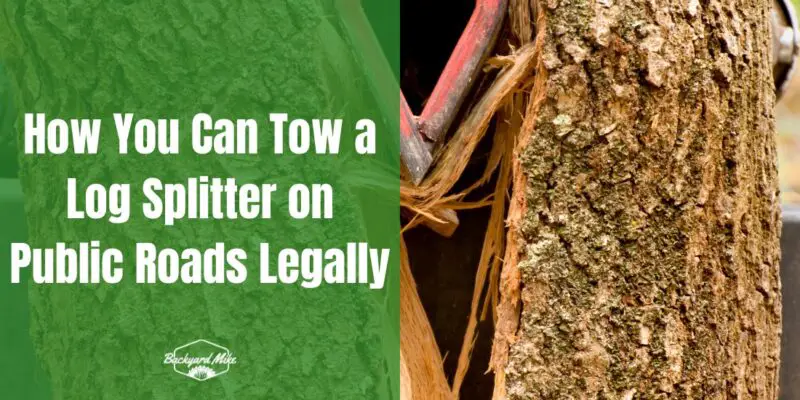To legally tow a log splitter on public roads, you should first check your state's towing laws, guaranteeing you meet licensing and registration requirements. Secure the log splitter with the appropriate hitch and safety chains, and verify compatibility with your towing vehicle's capacity. Use visibility aids like lights and SMV placards, and adhere to legal towing speeds. After towing, inspect equipment for damage. Proper preparation guarantees compliance, and there's more to understanding safe, legal towing.
Key Takeaways
- Verify state laws for registration requirements and towing permissions for log splitters on public roads.
- Consult local police to ensure compliance with towing regulations and legal practices.
- Use proper safety equipment, including lights, SMV placards, and safety chains, for visibility and security.
- Ensure the towing vehicle's capacity and hitch compatibility match the log splitter's weight and coupler size.
- Monitor weather conditions and plan routes to avoid adverse effects on towing safety.
Understanding Local and State Towing Laws
When towing a log splitter, understanding local and state towing laws is essential to confirm you're following all legal requirements.
Begin by checking if your state requires licenses or registrations for log splitters, as they're often considered unlicensed equipment. Towing regulations can vary, so familiarize yourself with state vehicle codes to avoid legal consequences. It's important to note that some states do not require registration for certain equipment, which can affect how you prepare for towing.
Check state regulations for log splitter licenses or registrations to avoid legal issues.
For instance, some states like California impose specific towing speed limits, such as 55 mph on highways. It's wise to verify if towing unregistered equipment on public roads is permissible in your area.
Additionally, consult local police for guidance on towing practices, as their interpretations can differ. Ascertain compliance by using trail markers or lights, even if not mandated, to avoid fines or further legal issues.
Ensuring Proper Safety Equipment and Setup
To guarantee safe towing of your log splitter, first secure it properly to your towing vehicle by selecting the correct hitch type and fastening it firmly. Install safety chains correctly by attaching them to both the splitter and the vehicle, allowing some slack for turning, while regularly checking for wear and damage. Always ensure that the log splitter is positioned on flat, even ground before attaching it to your vehicle to prevent instability during transport. Taking these steps helps prevent accidents and guarantees a stable transport experience.
Securing Log Splitter Properly
Securing a log splitter properly is vital for safe and legal towing, making certain both the equipment and those around it are protected.
Begin by attaching the splitter to your vehicle with a secure hitch and safety chains. This connection guarantees log splitter stability.
Some locations may require a license plate for towable splitters, while others may not.
When towing, keep your speed under 35 mph to maintain control, especially if your splitter lacks suspension. Reflective devices or slow-moving vehicle placards are essential for visibility.
Stabilize the splitter with blocks under its wheels during loading and unloading. Always allow enough clearance when turning to prevent jack-knifing.
Position the log splitter on a flat surface before use to avoid tipping. Regular maintenance of all components guarantees safety and reliability on the road.
Choosing Correct Hitch Type
Choosing the correct hitch type is essential for safely towing a log splitter. Start by ensuring your hitch can handle the log splitter's weight, typically around 112 lbs for smaller models. Consider the hitch type: a pin-style hitch works well for lawn tractors and ATVs, while larger setups might need a ball hitch. Check the hitch's weight class to match your tow vehicle's capacity. Inspect hitch materials like durable steel for long-term use, ensuring hitch durability. Secure the hitch with pins or locks to prevent detachment during transport. Make sure the hitch receiver size, commonly 2 inches, fits your vehicle's receiver. If height adjustment is possible, use it for improved towing stability. Always inspect for wear to avoid malfunctions. Portable and lightweight, this log splitter is suitable for tough logs like Oak, Elm, Walnut, and Cherry, making it a versatile choice for various wood-splitting tasks.
Installing Safety Chains Correctly
When installing safety chains, verify they're stronger than the log splitter's weight capacity to prevent accidents. Safety chains are crucial for trailer towing safety and are a legal requirement in many jurisdictions, emphasizing the importance of responsible towing practice. Choose safety chain materials that can withstand tension, making sure they don't grind on the ground if the hitch disengages. Proper chain installation techniques involve securing hooks and connections, which should be even stronger than the chains themselves. Remember, the chains need enough slack to allow smooth vehicle turns without dragging or catching. Check local and state regulations on towing safety equipment to verify compliance. Verify the log splitter is securely attached to your vehicle using the chains and a coupler. Regularly inspect them for wear and tear, as damaged chains could compromise safety. Always adhere to these guidelines for a secure towing experience.
Verifying Towing Vehicle and Trailer Compatibility
Before you hit the road with your log splitter in tow, it's essential to verify that your towing vehicle and trailer are compatible to guarantee safe and legal travel.
Start by confirming that your vehicle's weight capacity exceeds the combined trailer weight and log splitter. Check vehicle specifications, confirming the towing hitch matches the trailer coupler size, typically 2 inches.
Ensure your vehicle's weight capacity exceeds the combined weight of the trailer and log splitter.
Inspect the suspension and axles to verify they can handle the load. Confirm the brake system is suitable for towing heavier loads, and verify that the trailer wiring connects correctly to your vehicle's electrical system. Ensure support leg is up before towing to adhere to safety guidelines.
For the trailer, examine the coupler size, tire condition, and load distribution. Make sure rear reflectors are installed for maximum visibility on the road.
Implementing Necessary Safety Precautions
Before towing a log splitter, verify that all safety equipment is in proper working order, including secure hitches, safety chains, and functioning lights or reflectors. Monitor weather conditions closely, and avoid towing in hazardous situations like heavy rain or snow to maintain safety and compliance with regulations. It is also recommended to load the splitter onto a trailer if possible for safer transport, as this can provide additional stability and peace of mind during the journey.
Verify Safety Equipment
To guarantee safe towing of a log splitter, verifying the safety equipment is essential for both legal compliance and accident prevention. Start by confirming that safety chains are properly attached, using suitable safety chain types to secure the log splitter and towing vehicle. Check for adequate light requirements; the log splitter must have proper lights and reflectors for visibility, especially in low light. Verify the trailer coupler size matches the towing vehicle, assuring a stable connection, and secure it with a hitch pin. Attach stability flags for added visibility to other drivers. Ascertain the towing vehicle has a sturdy ball hitch and maintain proper tire pressure. Towing speed should generally be low unless the log splitter has suspension, as most commercially marketed splitters are rated for 35-45 mph tops.
Monitor Weather Conditions
After confirming the safety equipment, it's important to keep an eye on the weather conditions while towing a log splitter. Weather impacts your towing experience considerably, so using monitoring tools like weather apps can help you stay informed. Before you hit the road, check forecasts for rain, snow, or high winds, which can make roads slippery or reduce visibility. Proper preparation helps in choosing safer routes, ensuring you avoid areas prone to flooding or icing. Always plan your route to avoid areas prone to flooding or icing. If you encounter adverse conditions, reduce your speed and use traction aids like tire chains if necessary. Timing your trips during daylight is essential for better visibility. Equip your log splitter with flags or lights to increase its visibility.
Navigating Traffic and Roadway Considerations
When towing a log splitter, understanding how to navigate traffic and roadway considerations is essential for a smooth and safe journey. Ensuring road visibility is vital; consider using SMV placards or flags to alert other drivers. This helps prevent rear-end collisions, especially when maneuvering through traffic. Always tow at low speeds, ideally under 35-40 mph, due to the lack of suspension and visibility challenges. It is also important to comply with local laws regarding towing equipment to ensure legal compliance and safety. Be prepared for emergency maneuvers by familiarizing yourself with nearby pull-off locations. Avoid congested areas by traveling during off-peak hours or using local roads instead of highways. Smooth roads minimize bouncing, enhancing stability. Pay attention to pavement conditions, as towing on uneven surfaces can increase the risk of accidents. Prioritize safety and plan your route carefully.
Conducting Essential Post-Towing Checks
Once you've successfully navigated the roads with your log splitter in tow, it's time to focus on conducting essential post-towing checks to verify everything remains in good condition.
Conduct essential post-towing checks to ensure your log splitter remains in optimal condition.
Start with a final inspection to confirm no damage occurred during transport. Pay close attention to the hydraulic system, performing thorough hydraulic checks to identify any leaks or faults that may have developed. Proper maintenance after towing fosters a sense of safety and reliability within your community. It's important to note that some log splitters are not rated for high-speed travel on roads, so checking the manufacturer's guidelines before towing is crucial.
- Final Inspection: Examine the entire log splitter for signs of wear or damage.
- Hydraulic Checks: Inspect hydraulic lines and connections for leaks or damages.
- Secure Storage: Place the log splitter in a secure location to prevent theft or weather-related damage.
These steps help maintain the splitter's functionality and confirm readiness for future use.
Frequently Asked Questions
What Insurance Coverage Is Needed for Towing a Log Splitter?
You'll need liability insurance to cover potential damages or injuries while towing. It's essential to check towing requirements in your area, ensuring your insurance policy aligns with them. This keeps your community safe and compliant.
Are Permits Required for Long-Distance Towing of a Log Splitter?
When considering long-distance towing of a log splitter, you'll need to follow towing regulations and submit permit applications. Check state-specific rules, guarantee compliance, and join a community of responsible drivers who prioritize safety and legality on the road.
How Do I Handle Toll Booths While Towing a Log Splitter?
Approach toll booths slowly and use proper etiquette by informing attendants about your towing setup. Confirm you've got the exact change for any towing fees. Check your rig's security before leaving to confirm a smooth journey.
Can I Tow a Log Splitter During Restricted Hours?
You can't tow a log splitter during restricted hours without considering local towing restrictions. It's essential for road safety to know these rules, ensuring you travel when it's safe and allowed, fostering a sense of community responsibility.
What Are the Consequences of Improper Towing on Public Roads?
When you ignore towing violations, you risk hefty fines and jeopardize everyone's safety. Abiding by safety regulations helps you maintain community trust, protects your vehicle, and guarantees you're part of a responsible road-sharing community.
Conclusion
To legally tow a log splitter on public roads, you've got to navigate the maze of local and state laws, guaranteeing your setup is as tight as a drum. Check that your towing vehicle and trailer are compatible, and equip them with the right safety gear. On the road, stay vigilant, like a hawk scanning the terrain. After your journey, perform essential checks to verify everything's in order, keeping both you and your equipment safe.


